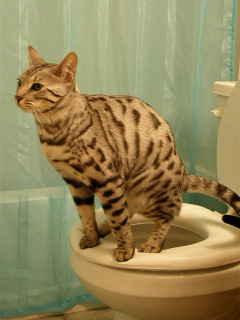The Risks of Flushing Cat Poop in Your Toilet - Precautionary Measures
The Risks of Flushing Cat Poop in Your Toilet - Precautionary Measures
Blog Article
Just about every person seems to have their own individual rationale with regards to Can You Flush Cat Poo or Litter Down the Toilet?.

Intro
As feline proprietors, it's important to bear in mind how we dispose of our feline close friends' waste. While it may seem practical to purge cat poop down the commode, this practice can have damaging repercussions for both the environment and human health and wellness.
Environmental Impact
Flushing feline poop presents dangerous pathogens and bloodsuckers into the water system, posing a substantial risk to water communities. These impurities can negatively impact aquatic life and compromise water top quality.
Wellness Risks
Along with environmental issues, flushing feline waste can likewise present health and wellness dangers to human beings. Cat feces may contain Toxoplasma gondii, a bloodsucker that can trigger toxoplasmosis-- a possibly severe disease, specifically for pregnant ladies and individuals with damaged body immune systems.
Alternatives to Flushing
Fortunately, there are much safer and extra responsible ways to throw away cat poop. Consider the complying with options:
1. Scoop and Dispose in Trash
The most usual technique of throwing away feline poop is to scoop it into a naturally degradable bag and throw it in the garbage. Make certain to make use of a dedicated litter scoop and get rid of the waste immediately.
2. Usage Biodegradable Litter
Select eco-friendly feline trash made from materials such as corn or wheat. These litters are environmentally friendly and can be safely gotten rid of in the garbage.
3. Bury in the Yard
If you have a lawn, think about burying cat waste in an assigned area away from vegetable yards and water resources. Make certain to dig deep sufficient to avoid contamination of groundwater.
4. Set Up a Pet Waste Disposal System
Purchase an animal waste disposal system specifically created for feline waste. These systems make use of enzymes to break down the waste, reducing odor and ecological effect.
Final thought
Accountable animal ownership expands past supplying food and sanctuary-- it likewise includes appropriate waste management. By avoiding purging feline poop down the toilet and going with different disposal techniques, we can minimize our environmental impact and secure human health and wellness.
Why Can’t I Flush Cat Poop?
It Spreads a Parasite
Cats are frequently infected with a parasite called toxoplasma gondii. The parasite causes an infection called toxoplasmosis. It is usually harmless to cats. The parasite only uses cat poop as a host for its eggs. Otherwise, the cat’s immune system usually keeps the infection at low enough levels to maintain its own health. But it does not stop the develop of eggs. These eggs are tiny and surprisingly tough. They may survive for a year before they begin to grow. But that’s the problem.
Our wastewater system is not designed to deal with toxoplasmosis eggs. Instead, most eggs will flush from your toilet into sewers and wastewater management plants. After the sewage is treated for many other harmful things in it, it is typically released into local rivers, lakes, or oceans. Here, the toxoplasmosis eggs can find new hosts, including starfish, crabs, otters, and many other wildlife. For many, this is a significant risk to their health. Toxoplasmosis can also end up infecting water sources that are important for agriculture, which means our deer, pigs, and sheep can get infected too.
Is There Risk to Humans?
There can be a risk to human life from flushing cat poop down the toilet. If you do so, the parasites from your cat’s poop can end up in shellfish, game animals, or livestock. If this meat is then served raw or undercooked, the people who eat it can get sick.
In fact, according to the CDC, 40 million people in the United States are infected with toxoplasma gondii. They get it from exposure to infected seafood, or from some kind of cat poop contamination, like drinking from a stream that is contaminated or touching anything that has come into contact with cat poop. That includes just cleaning a cat litter box.
Most people who get infected with these parasites will not develop any symptoms. However, for pregnant women or for those with compromised immune systems, the parasite can cause severe health problems.
How to Handle Cat Poop
The best way to handle cat poop is actually to clean the box more often. The eggs that the parasite sheds will not become active until one to five days after the cat poops. That means that if you clean daily, you’re much less likely to come into direct contact with infectious eggs.
That said, always dispose of cat poop in the garbage and not down the toilet. Wash your hands before and after you clean the litter box, and bring the bag of poop right outside to your garbage bins.
https://trenchlesssolutionsusa.com/why-cant-i-flush-cat-poop/

Do you really like reading about How to Dispose of Cat Poop and Litter Without Plastic Bags? Post feedback further down. We would be delighted to know your feelings about this write up. We hope that you come back again before long. Remember to set aside a second to share this article if you liked it. I thank you for reading our article about Can You Flush Cat Poop Down The Toilet?.
Get Your Estimate Now Report this page